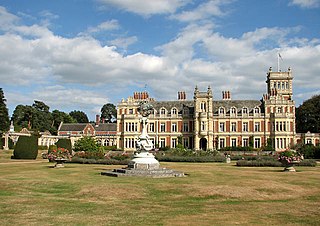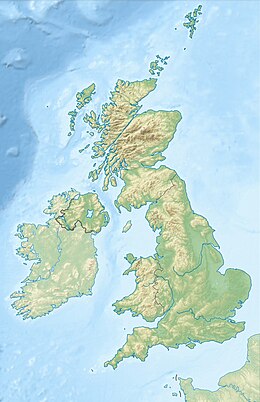
Belton House is a Grade I listed country house in the parish of Belton near Grantham in Lincolnshire, England, built between 1685 and 1687 by Sir John Brownlow, 3rd Baronet. It is surrounded by formal gardens and a series of avenues leading to follies within a larger wooded park. Belton has been described as a compilation of all that is finest of Carolean architecture, said to be the only truly vernacular style of architecture that England had produced since the Tudor period. It is considered to be a complete example of a typical English country house; the claim has even been made that Belton's principal façade was the inspiration for the modern British motorway signs which give directions to stately homes.

Bretton Hall is a country house in West Bretton near Wakefield, West Yorkshire, England. It housed Bretton Hall College from 1949 until 2001 and was a campus of the University of Leeds (2001–2007). It is a Grade II* listed building.

Lyme Park is a large estate south of Disley, Cheshire, England, managed by the National Trust and consisting of a mansion house surrounded by formal gardens and a deer park in the Peak District National Park. The house is the largest in Cheshire, and is recorded in the National Heritage List for England as a designated Grade I listed building.

Friar Park is a Victorian neo-Gothic mansion in Henley-on-Thames, England, construction began in 1889 and was completed in 1895. It was built for lawyer Sir Frank Crisp, and purchased in January 1970 by English rock musician and former Beatle George Harrison. The site covers about 30 acres, and features caves, grottoes, underground passages, a multitude of garden gnomes, and an Alpine rock garden with a scale model of the Matterhorn.

Eaton Hall is the country house of the Duke of Westminster. It is 1 mile (2 km) south of the village of Eccleston, in Cheshire, England. The house is surrounded by its own formal gardens, parkland, farmland and woodland. The estate covers about 10,872 acres (4,400 ha).

Somerleyton Hall is a country house and 5,000-acre (2,000 ha) estate near Somerleyton and Lowestoft in Suffolk, England owned and lived in by Hugh Crossley, 4th Baron Somerleyton, originally designed by John Thomas. The hall is Grade II* listed on the National Heritage List for England, and its landscaped park and formal gardens are also Grade II* listed on the Register of Historic Parks and Gardens. The formal gardens cover 12 acres (4.9 ha). Inspired by Knepp Wildland, Somerleyton is rewilding 1,000 acres (400 ha) of the estate to which he has introduced free-roaming cattle, large black pigs and Exmoor ponies.

Stowell Park Estate is a 6,000-acre (24 km2) historic agricultural and sporting estate in the Cotswold Hills, Gloucestershire, England. The estate includes the village of Yanworth. The main house is a Grade II* listed building and surrounded by extensive parkland, a mill, and church. The landscaped park is listed Grade II on the Register of Historic Parks and Gardens.

Helmingham Hall is a moated manor house in Helmingham, Suffolk, England. It was begun by John Tollemache in 1480 and has been owned by the Tollemache family ever since. The house is built around a courtyard in typical late medieval/Tudor style. The house is listed Grade I on the National Heritage List for England, and its park and formal gardens are also Grade I listed on the Register of Historic Parks and Gardens.
Bolesworth Castle is a country house 2 miles (3 km) south of the village of Tattenhall, Cheshire, England. It is recorded in the National Heritage List for England as a designated Grade II* listed building.

Burton Manor is a former manor house in the village of Burton, Cheshire, England. It is recorded in the National Heritage List for England as a designated Grade II listed building. At one time an adult education college, this is now closed, but the walled garden is open to the public and is administered by the Friends of Burton Manor Gardens.

Ammerdown House in Kilmersdon, Somerset, England, was built in 1788. It has been designated as Grade I listed building.

Ven House in Milborne Port, Somerset, England is an English manor house that has been designated as a Grade I listed building.

Hutton Court is a country house at Hutton, Somerset, England, built in the 15th century as a manor house. It is Grade II* listed on the National Heritage List for England. In addition to the main house, the boundary wall, summerhouse and the gates and piers to the hall are all separately Grade II listed. and stands immediately to the south of the parish church.

Bunny Hall is a 21,438 square feet (1,991.7 m2) grade I listed country house in Bunny, Nottinghamshire.

Frampton Court is a Grade I listed country house and estate of about 1,500 acres (610 ha) in Frampton-on-Severn, Gloucestershire, England. It has been owned by the Clifford family since the 11th century. The main buildings are the 18th century Frampton Court and, on the opposite side of the village green, Manor Farm. The gardens at Frampton Court have a Gothic orangery and ornamental canal in the style of William Halfpenny. The two houses, barn and orangery are all Grade I listed buildings in their own right, while the Gatepiers and Gates are Grade II* listed.

Trewithen House is a Georgian country house in Probus, Cornwall, England. The Palladian house was built by London-based architect Thomas Edwards in 1723. The house is listed Grade I on the National Heritage List for England, and its gardens are Grade II* listed on the Register of Historic Parks and Gardens.
Dunham Massey is a civil parish in the Metropolitan Borough of Trafford, Greater Manchester, England. It contains 48 listed buildings that are recorded in the National Heritage List for England. Of these, three are listed at Grade I, the highest of the three grades, one is at Grade II*, the middle grade, and the others are at Grade II, the lowest grade.
Swynnerton is a civil parish in the Borough of Stafford, Staffordshire, England. It contains 62 listed buildings that are recorded in the National Heritage List for England. Of these, two are listed at Grade I, the highest of the three grades, six are at Grade II*, the middle grade, and the others are at Grade II, the lowest grade. The parish contains villages including Swynnerton, Tittensor, Yarnfield, and Hanchurch, and the surrounding area. In the parish is the Trentham Estate, the area around the former Trentham Hall, most of which has been demolished. The remains of the hall, associated structures, and buildings in the garden and surrounding park are listed. Outside the estate, most of the listed buildings are houses and associated structures, cottages, farmhouses and farm buildings, the earlier of which are timber framed. The other listed buildings include churches and a chapel, items in churchyards, a country house and associated structures, buildings associated with a pumping station, bridges, and war memorials.
Farley is a civil parish in the district of Staffordshire Moorlands, Staffordshire, England. It contains 54 listed buildings that are recorded in the National Heritage List for England. Of these, five are at Grade II*, the middle of the three grades, and the others are at Grade II, the lowest grade. The most impressive building in the parish is the country house of Alton Towers. This, together with its surrounding gardens, were developed for the Earls of Shrewsbury in the early 19th century. The house and associated structures, and many items in the gardens are listed. Outside the grounds of the house, the parish contains the village of Farley and the surrounding countryside. The listed buildings here are mainly houses, cottages, and associated structures, farmhouses and farm buildings. The other listed buildings include structures in the former Alton Towers railway station, and two mileposts.
Parlington is a civil parish in the metropolitan borough of the City of Leeds, West Yorkshire, England. The parish contains 18 listed buildings that are recorded in the National Heritage List for England. Of these, two are listed at Grade II*, the middle of the three grades, and the others are at Grade II, the lowest grade. The parish was centred on the country house of Parlington Hall, but this was largely demolished in 1952. Most of the listed buildings are in the remaining estate, and include a triumphal arch, a bridge, a tunnel, the home farm, a garden house and associated garden walls, an icehouse, a group of stallion pens, a deer shelter, and lodges at the entrances to the grounds. The other listed buildings are a group of almshouses and associated structures, a farmhouse, and a milepost.




















